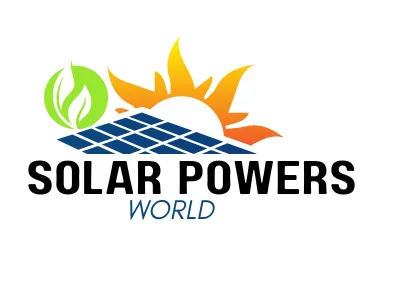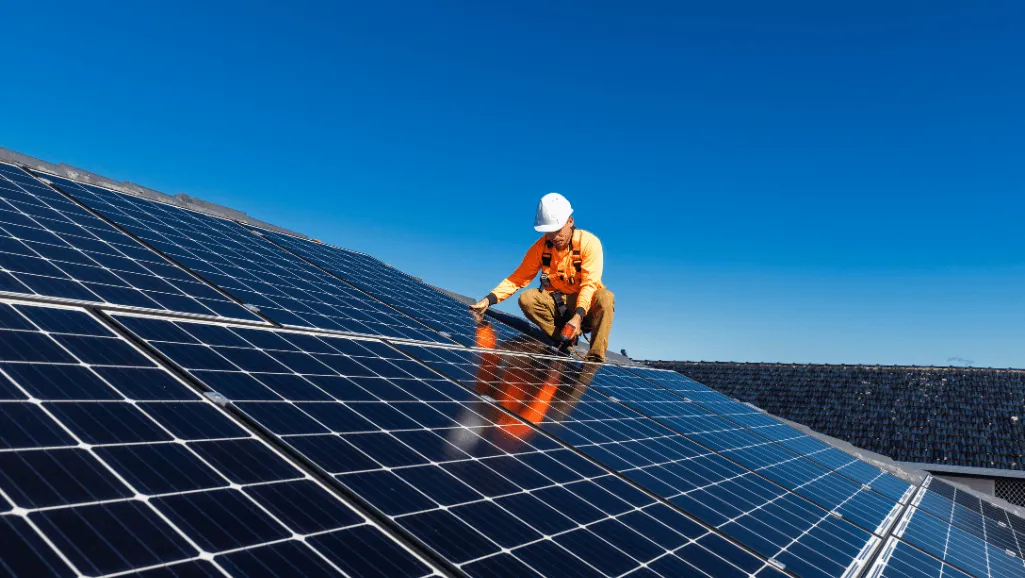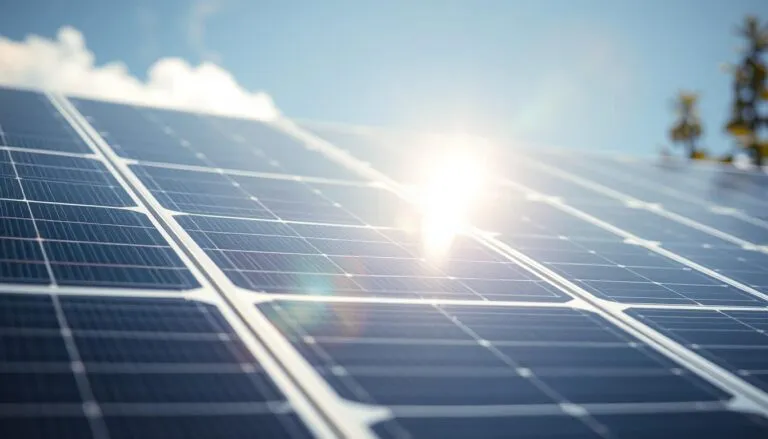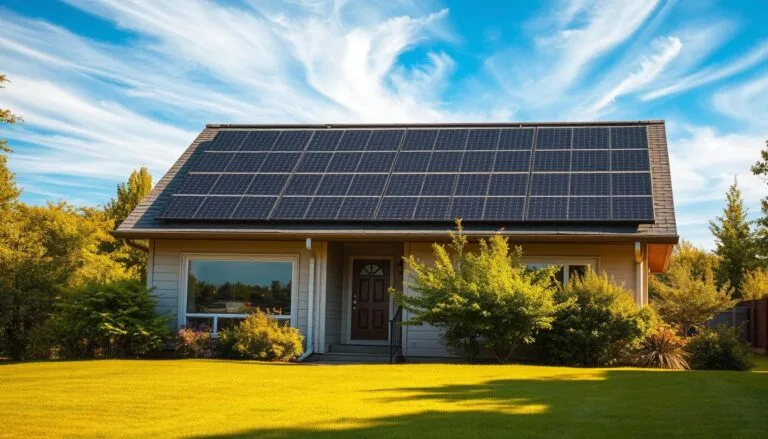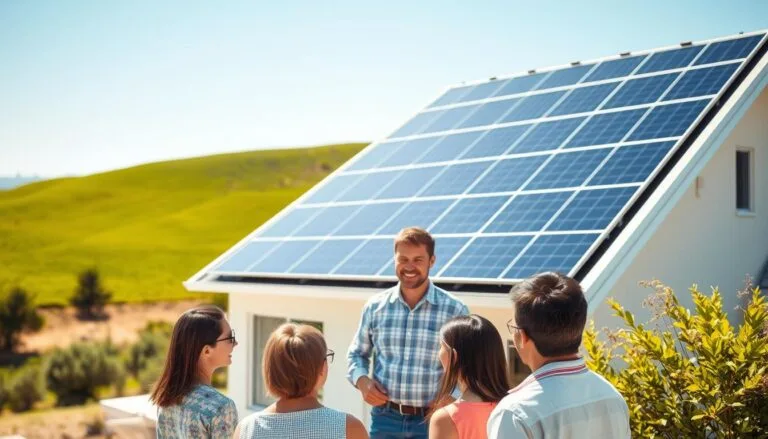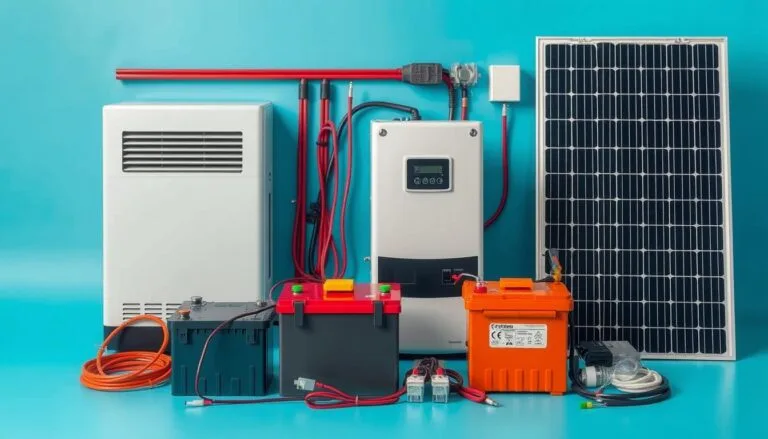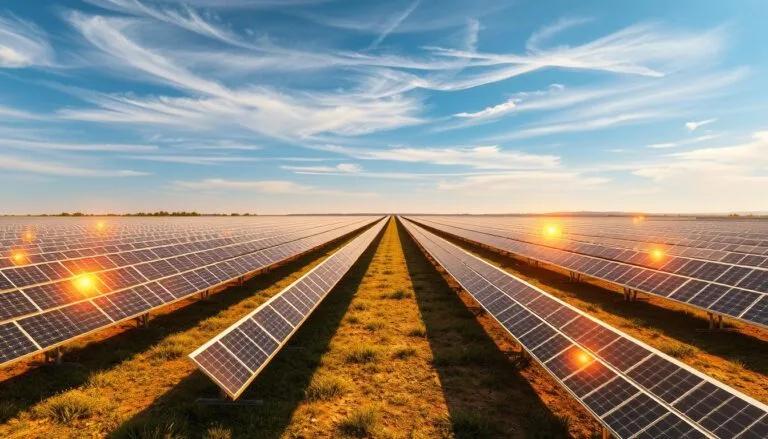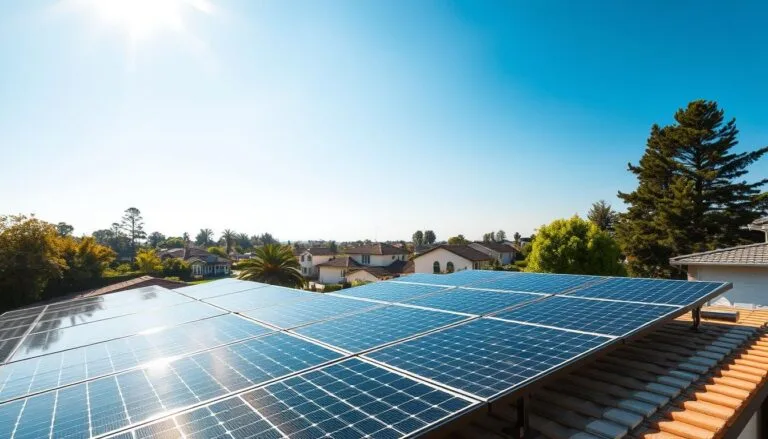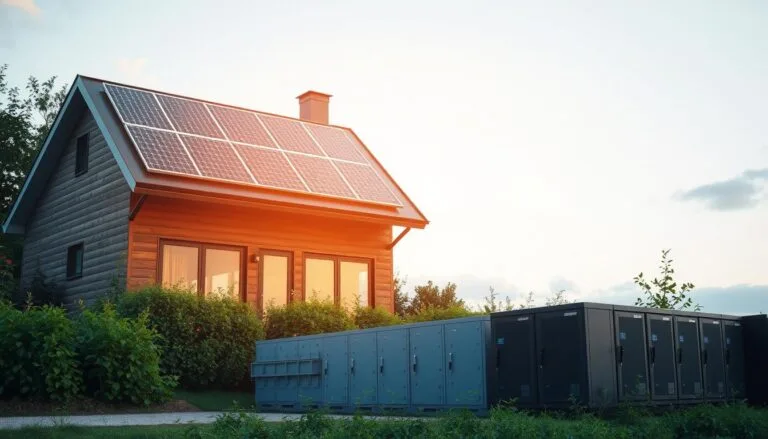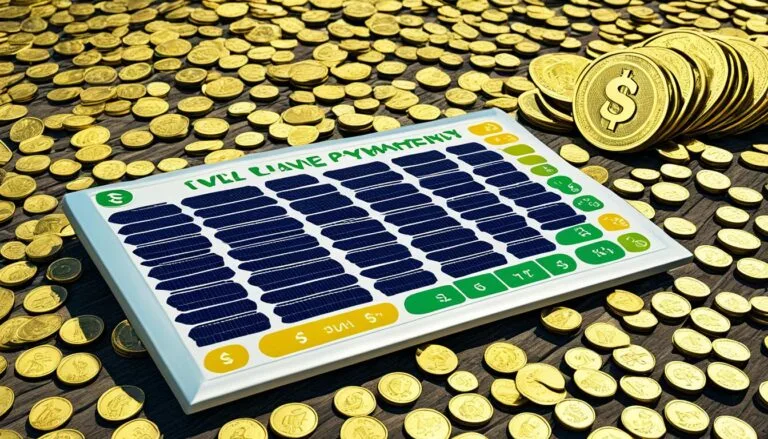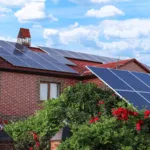Many homeowners wonder, “Does solar panels save money?” The answer is yes, thanks to lower installation costs and better technology. Using solar energy cuts down on energy bills and supports eco-friendly living.
The average electricity rate is $0.17 per kWh, and households spend about $1,834 a year on power. Solar panels offer a great financial benefit. With the federal solar tax credit, an 11 kW system costs around $20,948. State incentives and net metering make solar panels a smart financial move.
Even though solar panels cost about $30,000 upfront, the savings over time are huge. Homeowners can secure fixed energy rates, avoiding the usual 3.7 to 17.9-year payback period. Over the system’s life, savings can reach $28,000 to $120,000, highlighting solar panels’ role in financial and energy independence.
Key Takeaways
- The average homeowner saves about $48,000 over 25 years with solar installations.
- Costs for residential solar systems have dropped by about $15,000 in the last two decades.
- Solar panels work well in various climates, offering savings adjusted for local conditions.
- Incentives like the federal solar tax credit lower the cost of solar panel installations.
- Solar panels help cut energy costs, making it a solid financial strategy against rising utility prices.
- Increases in home value and earnings from net metering add to the savings on energy bills.
- The payback period depends on system size, panel quality, and local electricity costs.
Analyzing Solar Panel Cost Savings
Thinking about solar energy starts with looking at the costs. It’s important to see how the initial cost compares to long-term savings. By looking at local electricity costs and state prices, people can better understand the benefits of solar energy.
Understanding the Initial Investment vs. Long-term Savings
The high upfront cost of solar panels is often the main hurdle. A typical 6-kilowatt system costs about $18,604. This includes efficient monocrystalline panels, priced between $2.30 to $3.82 per watt. But, federal tax incentives can cover up to 30% of the cost, making solar more affordable.
Over time, the savings really add up. With solar panels, the average household’s electric bill drops to around $180 a year. Without solar, it’s about $1,430. Systems last 25 to 30 years, leading to big savings over time.
The Impact of Local Electricity Costs on Solar Savings
Where you live affects your solar savings. For example, the U.S. average electricity rate is about $0.1301 per kWh. But, prices vary by state. Places with higher electricity costs see faster savings from solar.
This means solar panels pay off quicker in states like Hawaii or California, where electricity is pricier. The payback period depends on local rates, sunlight, and rebates. In sunny, high-cost areas like Arizona and Nevada, solar panels return investments faster.
| State | Average Electricity Cost (per kWh) | Expected Annual Savings |
|---|---|---|
| California | $0.199 | $800 |
| Arizona | $0.129 | $500 |
| Texas | $0.118 | $300 |
By looking at these factors, homeowners can see the real value of solar energy. They can weigh the initial cost against future savings to make smart choices.
Calculating Your Solar Panels ROI
Understanding the return on investment (ROI) for solar panels is key for homeowners looking into this green energy option. It’s about looking at upfront costs, savings on energy bills, and incentives.
Factors Influencing Return on Investment
The ROI of solar panels depends a lot on the cost to install them. This cost can change a lot. On average, it’s about $16,000, but with a 26% tax credit, the cost drops a lot. Plus, some states offer more incentives, making solar panels more affordable.
These panels last 25 to 30 years, which adds to their value. They save money on utility bills for a long time.
Tracking Decreases in Energy Bills After Solar Installation
After putting in solar panels, it’s important to watch how energy bills go down. On average, people save about $125 a month. This means the savings can quickly cover the cost of the panels.
Using energy bill tracking tools helps homeowners see their savings and usage over time. This shows how well the investment is doing.
It usually takes 8 to 13 years for solar panels to pay for themselves, based on where you live and your electricity rates. But, solar panels can cut or even wipe out electricity bills. They might even make money by sending extra power back to the grid.
This makes the solar panels ROI very appealing. Switching to solar can make your money go further and even increase your home’s value by over 4%.
To figure out the solar panels ROI, you need to look at costs, savings, and benefits over the panels’ life. Homeowners should think about these factors to make the most of their solar investment.
The Economic Advantages of Solar Panels
Understanding the economic advantages of solar panels is more than just looking at the upfront costs. It’s about the long-term solar energy savings and how they are a cost-effective renewable energy option. Solar panels last about 25 to 30 years. They help reduce reliance on the grid and make financial planning more stable as electricity costs go up.
Solar panels can also increase the value of your home. Studies show that saving money on electricity bills can add about $20 to your home’s value for every dollar saved. Homes with these systems sell for about 4% more than those without them. This means big savings on utility bills right after installation.
Looking at the long-term, the savings add up over the life of the system. Here’s a look at how solar energy can save you money, compared to traditional power sources:
| Cost Element | With Solar Panels | Without Solar Panels |
|---|---|---|
| Initial Installation | $18,000 (pre-incentives) | $0 |
| Annual Energy Savings | $1,200 (approx.) | $0 |
| Resale Value Increase | 4% higher home value | No increase |
| Maintenance Cost (Annual) | $150 for inspection/cleaning | $0 |
| ROI Period | 6-10 years | Not applicable |
This data shows that solar panels are a smart choice for saving money. They’re especially good when you add in incentives and rebates like the federal tax credit.
In conclusion, switching to solar power in states like Florida brings environmental benefits and steady solar energy savings. With better technology, higher efficiency, and lower costs, the benefits of solar panels keep growing. This makes solar energy a smart financial move for those who invest early.
Does Solar Panels Save Money – Evaluating Financial Returns
Looking into the financial returns from solar panels means checking out savings on energy bills, government incentives, and higher property values. For those evaluating solar savings, the financial gains are big in many states, under the right conditions.
| Statistic | Detail |
|---|---|
| Average Payback Period | 5-7 years |
| Additional Home Value | 4.1% |
| Average Lifetime Savings | $21,000 |
| Annual Energy Bill Savings | $1,530 |
| Federal Tax Credit | 30% until 2034 |
Also, financial returns from solar panels come with a big win for the environment, making it a smart investment for two reasons. Homes with solar systems cut down on CO2 emissions. This shows how being green can also be good for your wallet.
Solar panels help lower monthly energy bills and offer more benefits like higher property values and tax credits. Indeed, homes with solar setups often sell for more, showing they have a market edge.
For a full look at the perks, think about both direct money savings and the big picture. Using solar energy is more than just saving money. It’s about creating a better future for our planet and our wallets.
Understanding the Costs: How Much Do Solar Panels Save?
Installing solar panels is often driven by the promise of saving money and being eco-friendly. The initial cost is high, but it leads to big savings over time. This is especially true when compared to traditional energy sources, which are pricier and less green.
Assessing the Average Energy Consumption Savings
In the U.S., the average monthly electricity bill hit $121.01 in 2021. States like Utah and Hawaii saw bills of $80.87 and $177.78, respectively. Solar panels can cut these costs a lot, depending on local energy rates and how much energy you use.
Strong solar systems can cover all your energy needs in some states with lower usage. A 7.15 kW system matches average use well. This means you could save money over time, enough to pay for the setup costs, which averaged $3.28 per watt in early 2023.
For a closer look at how solar panels can save you money, check out what experts say at how much solar panels save. They offer tailored advice based on your area and energy use.
Comparing Solar Panels to Traditional Energy Sources
Traditional energy prices can swing wildly due to things like fuel market changes and global events. Solar energy, on the other hand, is more stable. Plus, solar costs don’t go up like traditional energy does, thanks to things like the Federal Solar Tax Credit.
Different states have different electricity rates, like Washington’s 10.11 cents per kWh versus Hawaii’s 33.49 cents. This shows why solar is a smart choice in places with high energy costs, making it a cost-effective option.
Solar panels cut down on your bills and help the planet over their long life. This makes them a strong choice when compared to traditional energy sources.
| State | Average Monthly Electricity Bill (Pre-Solar) | Estimated Monthly Solar Savings |
|---|---|---|
| Utah | $80.87 | $80.87 |
| Hawaii | $177.78 | $177.78 |
| Washington | $121.01 | $110.00 (approx.) |
Solar panels help lower your electric bills and support a greener future. With the right incentives and setup, they offer big savings and environmental benefits.
Assessing the Solar Panels Financial Benefits
Switching to solar energy is a big step towards being green and also a smart money move. Homeowners can save a lot on energy bills and see financial benefits over time. This is thanks to the solar financial benefits like big cost cuts.
Exploring Tax Incentives and Solar Rebates
Tax incentives are key to making solar energy affordable. The U.S. Department of Energy offers a credit for solar systems. This lets homeowners deduct 30% of the system’s cost from their taxes. With solar rebates at the state level and from programs like DSIRE, the upfront cost drops. This makes solar energy more accessible to everyone.
The Long-term Financial Impacts of Solar Energy Use
The benefits of solar energy last a long time. Solar systems can last 25 years, cutting down electricity bills a lot. The U.S. saw solar power grow from 1.2 GW in 2008 to 27.4 GW in 2015. This shows more people trust and rely on solar power.
Also, solar panels are getting cheaper, making solar a smart choice for the future. This leads to more people using solar power for both the planet and their wallets.
| Year | Solar Power Capacity (GW) | Estimated Cost Reduction (%) |
|---|---|---|
| 2008 | 1.2 | 0% |
| 2015 | 27.4 | Approx. 70% |
In conclusion, solar technology is a smart choice for a clean energy future. It offers great solar financial benefits through tax incentives, solar rebates, and long-term savings for homes.
Maximizing Savings: Decreasing Energy Bills with Solar Panels
The search for maximizing solar savings and decreasing electric bills is easier now with modern solar tech. Solar panels cut down your energy bills and boost your home’s value. They also offer green energy solutions. By investing in solar, you can lessen your reliance on utility companies and protect yourself from price hikes.
Financial Impact: Investing in solar is more than just putting panels on your roof. It means understanding net metering, tax credits, and state incentives for big savings. This is especially true in places like California, where energy costs are high, making solar savings even better.
| Benefit | Description | Approximate Savings |
|---|---|---|
| Solar Panel Installation | Reduces reliance on grid power, leading to lower monthly bills. | $77/month* |
| Federal Solar Investment Tax Credit (ITC) | Covers 30% of the solar PV system cost. | Significant reduction in upfront costs |
| Net Metering | Credits for surplus energy returned to grid. | Can offset future bills or lead to cash payouts |
| Home Value Increase | Higher property valuation in solar-equipped homes. | Up to $15,000 additional value |
Solar panels offer big savings on your electric bills. With rates going up every year, solar gives you a stable, cheaper energy source. Plus, with battery storage, you can use more of your solar energy, making your investment even better.
To get the most from your solar investment, add energy-saving steps like LED lights and smart home devices. These can cut your energy use even more. With these steps, getting to a zero energy bill is possible, showing the big economic and environmental benefits of solar.
For the best solar savings, mix new tech, smart energy use, and financial incentives. With the right solar setup, you can start cutting your electric bills and building a green financial future.
State-by-State Solar Savings Breakdown
Looking into solar energy savings shows how important location is. Each state’s sunlight, electric rates, and incentives affect how much you can save. We’ll look at some interesting state comparisons to show these differences clearly.
Why Geographic Location Matters for Solar Panel Savings
Where you live greatly affects how well solar panels work and how much you save. Places like Arizona get a lot of sun, so solar panels there produce more energy. On the other hand, places like Washington get less sun, so panels there don’t work as well.
Sunlight levels and electric rates also play a big role in how much money you can save with solar. For example, Arizona gets about 12,000 kWh a year from a 6 kW system. Washington gets almost half that amount because it’s not as sunny.
Comparative Analysis: Potential Savings Across Various States
Different states have different levels of sunlight and incentives, which affects how much money you can save. Here’s a look at some important data:
| State | Annual kWh Production | Estimated Savings Over 20 Years |
|---|---|---|
| Arizona | 12,000 kWh | $96,000 |
| Washington | 6,500 kWh | $27,003 |
| California | 11,000 kWh | $113,272 |
Arizona and California have a lot of sun and high electric rates, which means big savings on solar panels. Even with differences in sunlight, knowing about state incentives can help you save more money. This is shown in articles like solar savings comparison and state-specific solar incentives analysis.
It’s important to understand these differences for people thinking about solar panels. Knowing about local rules and incentives can help you make the best choice. The savings and financial benefits of solar panels depend on where you live and the energy situation there.
Conclusion
This article shows that investing in solar panels is a smart move for both homeowners and businesses. The cost to install solar panels in places like Seattle ranges from $10,000 to $30,000. Over time, the benefits make the initial cost worth it.
The 30% Federal Investment Tax Credit (ITC) helps lower the cost even more. This makes solar panels a financially smart choice. By using solar energy, people save money on their electricity bills and help the environment by reducing greenhouse gas emissions.
Installing solar panels can also increase the value of your property. For homes, the cost before tax credits is between $17,400 and $23,900. These systems can last for many years, making them a good investment.
Having solar power means you’re not affected by rising energy costs. This makes solar energy a smart choice for the future. It offers energy independence and fixed rates, which can save you money over time.
Commercially, solar energy is becoming more viable. It offers long-term cost savings for both homes and businesses. The data shows that using solar power is a smart economic move and a step towards energy independence.
But, it’s important to do your homework before investing in solar panels. Consider your location and energy needs to get the most out of your investment.

